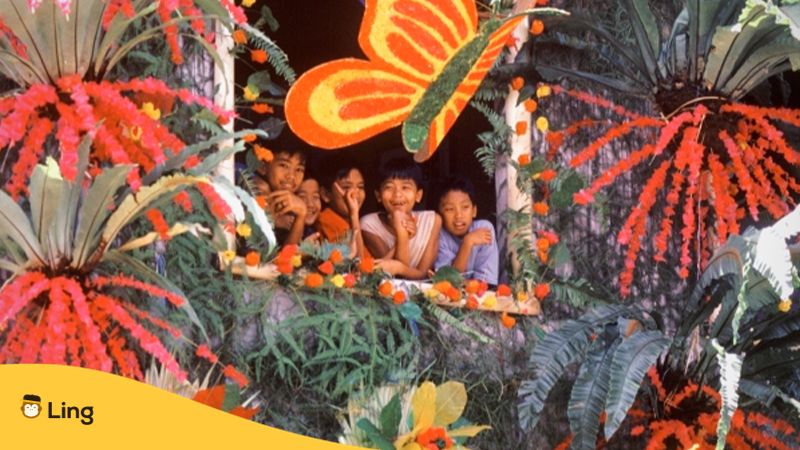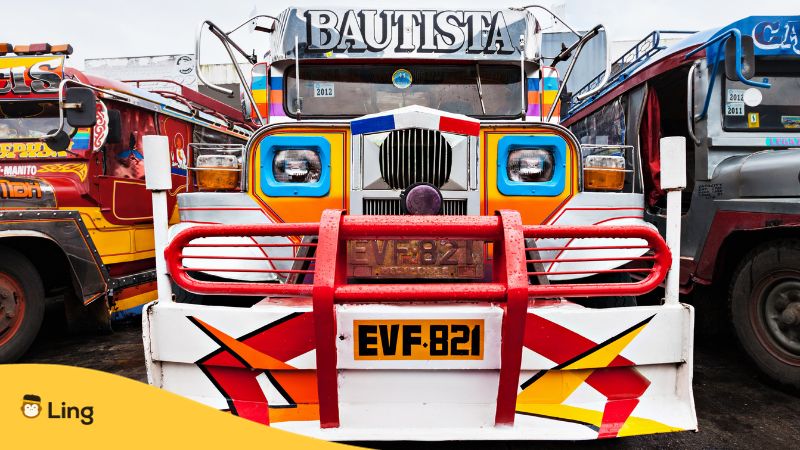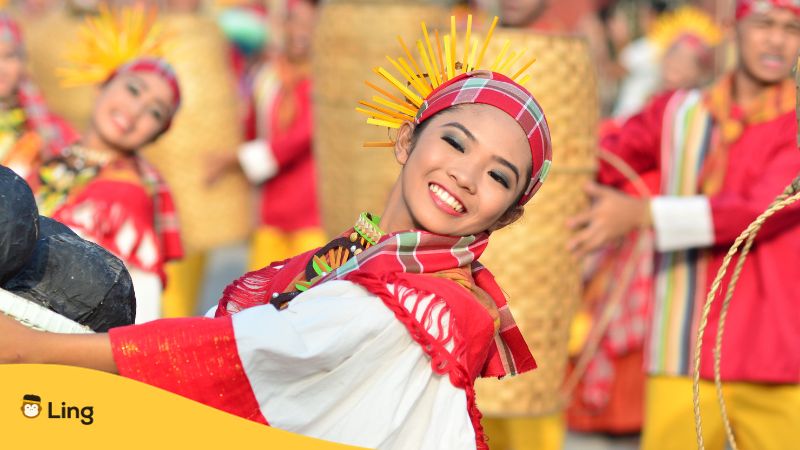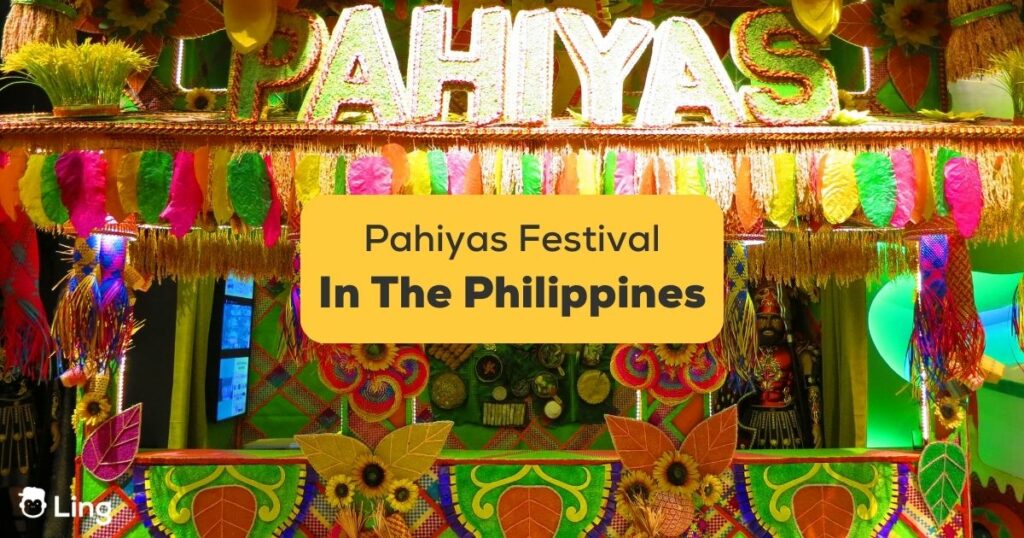Have you ever found yourself amidst a riot of colors, tantalizing aromas of food wafting through the air, and the melodic tunes of a festival that radiates joy? If not, fasten your virtual seatbelts and come with me on a journey to the Philippines! A couple of years ago, I was fortunate enough to stumble upon the Pahiyas festival in the heart of Lucban, Quezon, and let me tell you – it was nothing short of magical.
Just imagine streets draped in rainbow-hued decors (or palamuti in Tagalog), houses adorned with the most vibrant produce you’ve ever seen, and the palpable excitement of locals and visitors alike. It’s like stepping into a painting where every stroke is infused with gratitude and celebration.
By the time I bid goodbye, my camera was bursting at its digital seams, my tastebuds were in a happy dance from the Filipino treats, and my heart? It was full of tales, newfound friends, and a quiet vow to come back. If your heart beats for culture, vibrancy, and life’s finest celebrations, read on.
What Is Pahiyas Festival All About?
At its core, the Pahiyas Festival is a thanksgiving event. Every 15th of May, the residents of Lucban, Quezon, come together to offer their gratitude to San Isidro Labrador, the patron saint of farmers, for a bountiful harvest. It’s a tradition that dates back centuries, reflecting the town’s agricultural roots and the Filipinos’ deep connection with nature.
One of the first things you’ll notice are houses festooned with a myriad of decorations, notably the vibrant kiping, leaf-shaped rice pastries dyed in a rainbow of colors. They’re hung in intricate patterns, often resembling chandeliers or large flowers. And the best part? They’re edible!
Beyond the kiping, houses are decorated with the freshest produce, from gleaming eggplants to plump tomatoes and golden grains, all artfully arranged. This not only showcases the region’s agricultural wealth but also kindles a spirit of healthy competition among residents to outdo each other in creativity.
The streets come alive with parades featuring local bands, traditional dancers, and even colorful carabao (water buffalo) races. It’s an auditory and visual treat that showcases the region’s rich cultural tapestry.
As you wander, be sure to savor the flavors of the festival. Dive into a plate of pansit habhab, a local noodle delicacy eaten off a banana leaf, and wash it down with cool, refreshing coconut juice. And if you’re a fan of pastries, don’t miss out on the kiping – yes, you can actually eat those beautiful decorations!
What truly sets Pahiyas apart is the community’s involvement. It isn’t a festival put on for show; every resident, young and old, participates with gusto. They open their homes to visitors, share stories, and proudly showcase their handiwork.

Where Is The Pahiyas Festival Celebrated?
The epicenter of the Pahiyas Festival is the town of Lucban. Nestled in the province of Quezon, this town isn’t just known for its grand festival but also its rich history and scenic beauty. Picture a place with rolling hills, clear blue skies, and a tapestry of green fields – that’s Lucban for you.
Positioned at the foot of the mystical Mount Banahaw, Lucban boasts a blend of natural beauty and cultural significance. The town carries an old-world charm, with Spanish-era churches, ancestral homes, and cobblestone streets. But come mid-May, this serene town transforms into a riot of colors and festivities.
While Lucban is the heart and soul of the Pahiyas Festival, its essence spills over to neighboring towns in Quezon. Each town has its unique twist and traditions associated with the festival, making it a broader celebration across the province. If time permits, exploring these adjacent towns can offer a fuller picture of the region’s festive spirit.

When Is Pahiyas Festival Celebrated?
Now that you’re mentally mapping out Lucban and imagining its vibrant streets, it’s crucial to circle that specific date on your calendar. After all, timing is everything! So, when exactly does this kaleidoscope of colors, flavors, and sounds come to life? Let’s dive right in.
The Pahiyas Festival is celebrated every 15th of May, come rain or shine. This date isn’t arbitrary but deeply symbolic, commemorating the feast day of San Isidro Labrador, the patron saint of farmers.
You might wonder, out of all the days in the year, why is the 15th of May so special? Well, it ties back to the essence of the festival – gratitude for a bountiful harvest. May is typically the end of the dry season in the Philippines, signaling the onset of the planting season. By celebrating on this day, the farmers express their gratitude for the past harvest and pray for another prosperous season ahead.
While the grand celebration happens on the 15th, the festive spirit starts brewing days in advance. In the week leading up to the festival, Lucban starts its transformation. Homes begin their decorative endeavors, stalls pop up offering delectable treats, and there’s a general buzz in the air. If you’re looking for a full experience, it might be worth arriving a few days earlier to soak in the preparatory fervor.
How Is Pahiyas Festival Celebrated?
Alright, eager traveler! Now that we’ve covered the where and when of the Pahiyas Festival, let’s delve into the most exciting part – the how. The heart and soul of the festival lie in its traditions, activities, and those little moments of magic. Ready to dive deep into the whirlwind of festivities? Let’s unravel the tapestry of celebrations.
The Vivid Decorations
Homes throughout Lucban transform into vibrant canvases. The star of the show is the kiping, those vividly colored, leaf-shaped rice pastries that adorn walls, windows, and doorways. But there’s more! Houses also display bountiful produce, from cascading veggies to stringed fruits, showcasing the year’s harvest and the town’s agricultural prowess.
The Street Parade
The morning air is filled with excitement as the grand parade kicks off. Floats adorned with flowers and produce, dancers swaying to traditional tunes, and, occasionally, the delightful sight of decorated carabaos (water buffaloes) waltzing down the streets. The energy is infectious, and you’ll find yourself swaying along in no time!
The Competition
Yes, you heard it right! Residents engage in a friendly competition, vying for the title of the ‘Best Decorated House’. Judges roam the streets, assessing creativity, use of materials, and adherence to tradition. The winning house isn’t just bestowed with a title, but also cash prizes and, of course, year-long bragging rights!
Delightful Culinary Adventures
A festival isn’t complete without its share of gastronomic delights. Indulge in traditional treats like pansit habhab, sipped directly from a banana leaf, or savor the sweetness of freshly made kiping. And don’t miss out on the famous Lucban longganisa, a local sausage that’s a burst of flavors.
Religious Processions
While merriment fills the air, the festival’s religious essence remains intact. The image of San Isidro Labrador is paraded through town, blessing fields and homes along the way. Many devotees follow the procession, offering prayers for a bountiful season ahead.
Back then, farmers would bring their harvest to the town church and the parish priest would bless them as a way to give thanks to the Lord for their bountiful harvest. But as time progressed, the church can no longer accommodate all harvests. It was then agreed upon for the harvests to be displayed in the farmers’ houses instead.
Night-time Revelries
As the sun sets, the town doesn’t sleep. Candlelit processions lend a serene aura, and local bands take over, filling the night with music and dance. And if you’re lucky, you might stumble upon a local ‘sayawan’ or street dance where everyone – locals and visitors alike – join in the fun.

How To Go To The Pahiyas Festival?
So, you’re all pumped up for the Pahiyas Festival and ready to dive into the heart of the celebrations. But wait, how do you get there? And more importantly, how much is it going to cost? No worries, traveler, I’ve got you covered! Here’s a comprehensive guide to ensure a smooth journey to Lucban and help you budget your trip efficiently.
Traveling By Air
From Abroad
Manila’s Ninoy Aquino International Airport (NAIA) is the primary international gateway to the Philippines. Prices vary based on departure cities and airlines, so it’s best to check airline websites or booking platforms for the latest rates.
From Other Philippine Cities
If you’re traveling from another city within the Philippines, you’ll likely land at NAIA or Clark International Airport. Domestic flights to Manila range from PHP 2,000 to PHP 5,000, depending on the airline, season, and how early you book.
Traveling By Bus
Several bus companies operate routes from Manila to Lucban. Among the popular ones are JAC Liner and JAM Liner. These buses are usually stationed in Cubao, Buendia, and Alabang. Basically, the trip takes approximately 3 to 4 hours with an estimated cost of PHP 250 to PHP 400 for a one-way trip.
Traveling By Car
If you prefer a road trip, renting a car is a fantastic option. The journey from Manila to Lucban via the South Luzon Expressway (SLEX) is scenic and straightforward. Be warned though because car rentals range from PHP 2,500 to PHP 5,000 per day, depending on the vehicle type and rental company. Don’t forget to factor in fuel costs, which might add another PHP 1,000 to PHP 2,000 for a round trip.
Organized Tours
Several travel agencies offer day tours or overnight packages to the Pahiyas Festival. These often include transportation, meals, and sometimes accommodations. You can expect to shell out around PHP 2,000 to PHP 5,000, depending on the inclusions and agency.
Local Transportation
Once in Lucban, the primary modes of transportation are tricycles and jeeps. They’re perfect for short distances or if you’re staying a bit away from the main festival area. Basically, you can expect to pay around PHP 20 to PHP 50 for tricycles, depending on the distance. On the flip side, jeeps have a standard fare starting at PHP 9 for the first few kilometers.

Tips For Attending The Pahiyas Festival
Gear up, traveler! If you’re venturing into the heart of the Pahiyas Festival, some inside tips can make your experience tenfold more memorable. But we’re not talking about your everyday, run-of-the-mill advice. These are actionable, specific, and tailored just for you. Ready to get the most out of Pahiyas? Let’s dive right in.
Map Out Key Locations
Before you set foot in Lucban, grab a festival map (usually available online or at tourist information centers). Highlight key areas – the main parade route, popular houses known for their decorations, and emergency facilities (like clinics or police stations).
Action: Bookmark the Lucban tourism website on your phone or print out a physical map.
Get Your Street Food Game On
While there are plenty of restaurants, the street food during Pahiyas is legendary. Look out for stalls selling pansit habhab, kiping, and Lucban longganisa.
Action: Carry small denominations of PHP 20s and PHP 50s to easily pay street vendors.
Secure Prime Viewing Spots Early
For the parade, certain junctions or bends in the road offer the best views, as participants slow down.
Action: Scout these spots the day before and try to secure your place at least an hour in advance on festival day.
Hydrate, But Smartly
With the May heat, staying hydrated is key. However, you also don’t want to be searching for restrooms every hour.
Action: Sip water regularly but avoid chugging down large quantities at once. Carry a reusable water bottle to refill at designated stations.
Dress Smart
Comfort is paramount, especially with the amount of walking and the tropical heat.
Action: Opt for light, breathable clothing. Wear comfortable walking shoes, preferably closed-toed to prevent accidental stepping during crowd surges. Don’t forget a hat and sunglasses!
Engage with Locals
The true spirit of Pahiyas lies in its people. Engage in conversations, ask about the stories behind their house decorations, or even join in local dances.
Action: Learn a few basic Filipino phrases. Simple words like Salamat (Thank you) or Magandang Araw (Good Day) can work wonders.
Capture the Moment, Respectfully
While it’s tempting to snap photos everywhere, be respectful. Some locals might prefer not to be photographed.
Action: Always ask for permission before taking close-up shots of locals or entering someone’s property for a better angle.
Stay Connected
With the crowd, it’s easy to get separated from your group.
Action: Designate a meet-up point in case anyone gets lost. Also, consider getting a local SIM card (preferably from Globe or Smart) to ensure you have mobile data and can contact others if needed.
Watch Your Belongings
Like any crowded event, there’s always a risk of pickpockets.
Action: Use anti-theft bags or backpacks with concealed zippers. Carry essentials and avoid flaunting expensive jewelry or gadgets.
Tagalog Words Related To The Pahiyas Festival
If you’re attending the Pahiyas Festival or even just reading about it, knowing some related Tagalog terms can add a layer of richness to your experience. These words not only allow you to communicate better but also offer a glimpse into the culture and essence of the celebration. Here are some terms you might come across:
Ani: The Heartbeat of Agriculture
Ani stands for “harvest.” In a land of agricultural heritage, harvest time is more than just reaping crops; it’s a reflection of a year’s hard work, hopes, and aspirations. For travelers, understanding the significance of ani provides insight into the essence of many Filipino festivals, especially Pahiyas, where gratitude for bountiful harvests takes center stage.
Pansit Habhab: A Taste Adventure on a Banana Leaf
When in Lucban, make room for Pansit Habhab! It’s not just any noodle dish. Served on a banana leaf, this local delicacy encapsulates the area’s flavors and traditions. The term “Pansit” is a general reference to noodles, while “habhab” captures the unique, utensil-free eating style. Get ready to munch directly off the leaf, and don’t be shy — it’s the local way!
Longganisa: More than Just a Sausage
Longganisa might mean “sausage” in Filipino, but each region brings its twist, with Lucban’s being a must-try. Garlicky with a hint of sourness, Lucban longganisa embodies the town’s culinary identity. When mingling with locals, mentioning your love (or newfound discovery) of their longganisa is sure to spark joy and camaraderie.
Pasasalamat: More Than Just a Thank You
Pasasalamat delves deep into the Filipino psyche. More than just “thanksgiving” or “gratitude,” it’s an outpouring of genuine appreciation. The Pahiyas Festival is, at its core, a grand pasasalamat to nature for the year’s abundant blessings. As a traveler, joining in this collective gratitude will undoubtedly make your experience more meaningful.
Parada: Where Colors and Cultures Converge
Every major festival in the Philippines boasts its parada or “parade.” These aren’t just simple processions but vibrant displays of local culture, talent, and creativity. During Pahiyas, the parada is a spectacle of colors, with floats and participants showcasing Lucban’s best. Make sure to grab a good vantage point early!
Bahay: Not Just a House, but a Home
Bahay is the Filipino term for “house.” But during Pahiyas, each bahay transforms from a mere dwelling into a canvas of artistic expression. Households go all out to decorate their facades, turning the town into a living art gallery. As you stroll through Lucban, take a moment to appreciate the effort and creativity poured into each bahay.
Timpalak: Friendly Competition, Lucban Style
The word timpalak might sound foreign, but its meaning — “contest” or “competition” — is universal. In the spirit of friendly rivalry, Lucban houses vie for the best decoration prize during Pahiyas. But beyond the accolades, the timpalak embodies the town’s community spirit and shared pride.
Bayanihan: The Spirit of Togetherness
The term bayanihan is quintessentially Filipino. Although not exclusive to Pahiyas, it’s seen in full force during the festival. It encapsulates community unity, cooperation, and a collective sense of purpose. As you witness people helping each other prepare for the festivities, you’re seeing bayanihan in action.
Araw: Day, Sun, and More
Araw means “day,” but it also refers to the sun. The Pahiyas Festival is celebrated on a specific araw in May, marking the culmination of the harvest season. In Lucban, it’s an araw filled with vibrancy, enthusiasm, and gratitude.
Saya: The Universal Language of Joy
Lastly, we have saya, translating to “joy” or “happiness.” At the heart of Pahiyas is the overwhelming saya of the locals, a testament to their indomitable spirit and zest for life. And as the saying goes, joy is contagious — let Lucban’s saya sweep you off your feet!
Learn Tagalog With Ling
Got a spark of interest to delve deeper into Tagalog? Great news awaits! Elevate your Philippine adventures by snagging the Ling app from the App Store or Play Store. With Ling, you’re not just picking up a language; you’re embracing the poetic rhythm of Tagalog, enriching every conversation and etching memories in vibrant colors.
Keep in mind, every festivity, every custom, every uttered word is a narrative waiting to unfold. By immersing in these tales, you aren’t merely stepping into a destination; you’re weaving yourself into its grand story. So, as you reflect on the wonders of the Pahiyas Festival, may it stand as a beacon of the splendors found in discovery, comprehension, and kinship. Here’s to enriching journeys ahead!



































































